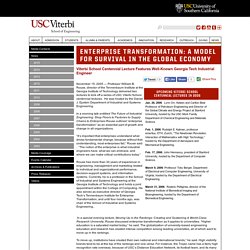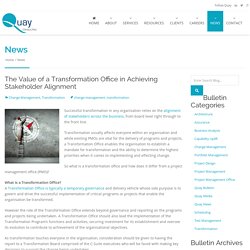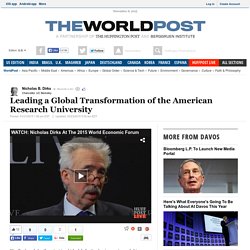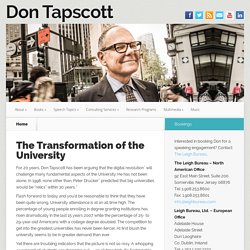

T10 Strategic Planning - Office of the Provost and Senior Vice President. We are pleased to announce that on November 2, 2013 the Board of Trustees approved the T10 Strategic Plan.

Since the release of the T10 Strategic Plan, the Office of the Provost in collaboration with students, faculty, staff, alumni, parents, and friends from around the university have begun to implement Strategic Planning Initiatives such as Tufts 1+4 and Bridge Professorships. Where can I read the plan? Read the Full Report: T10 Strategic Plan Full Report. Read the Executive Summary: T10 Strategic Plan Executive Summary. Enterprise Transformation: A Model for Survival in the Global Economy. November 15, 2005 — Professor William B.

Rouse, director of the Tennenbaum Institute at the Georgia Institute of Technology delivered two lectures to kick off a series of USC Viterbi School centennial lectures. He was hosted by the Daniel J. Epstein Department of Industrial and Systems Engineering. In a morning talk entitiled The Future of Industrial Engineering: Shop Floors to Factories to Supply Chains to Enterprises Rouse outlined “enterprise transformation” as an essential part of growth and change in all organizations. “It’s important that enterprises understand what drives fundamental change, because without that understanding, most enterprises fail,” Rouse said . Rouse has more than 30 years of experience in engineering, management and marketing related to individual and organizational performance, decision-support systems, and information systems.
To move up, institutions have created their own national and international brands,” he said. ABOR-Strategic-Plan. BassisPrimer. National University of San Marcos (UNMSM) Creates an Enterprise Architecture and BPM Innovation Center Using AuraPortal Technology. Education architecture guidebook. Ecs0212. The value of a Transformation Office in achieving stakeholder alignment. Successful transformation in any organisation relies on the alignment of stakeholders across the business, from board level right through to the front line.

Transformation usually affects everyone within an organisation and while existing PMOs are vital for the delivery of programs and projects, a Transformation Office enables the organisation to establish a mandate for transformation and the ability to determine the highest priorities when it comes to implementing and effecting change. So what is a transformation office and how does it differ from a project management office (PMO)? What is a Transformation Office? A Transformation Office is typically a temporary governance and delivery vehicle whose sole purpose is to govern and drive the successful implementation of critical programs or projects that enable the organisation be transformed. Science 2013 Mervis 292 6. Engaged instruction. Carl. Engaged instruction.

Carl Wieman uses active learning tools to teach an undergraduate course at the University of Colorado in 2001. for faculty members through their authority to hire, promote, and grant tenure, he says. So the best way to sustain improvements in teaching and learning is to get departments to buy into the need to change the courses that they offer. And that’s begun to happen at UBC, one of Canada’s elite universities. Wieman’s passion for the subject, combined with his stature as a Nobelist, has focused national attention on the high attrition rate among students who declare an interest in earning a degree in a STEM (science, technology, engineering, and mathematics) fi eld. It’s one of the biggest impediments to any effort to train more scientists and engineers. Leading a Global Transformation of the American Research University We all acknowledge the extent to which globalization has in recent years led to unprecedented levels of change in areas from the economy to the environment, from the way we do business to the way we interact with media.

With the pace of globalization accelerating and its impact expanding, universities have begun to change as well, seeing increasing numbers of students flow beyond national borders, coordinating if not standardizing degrees and calendars, and collaborating both in research and in teaching. Despite these efforts, there is still no consensus about what globalization will ultimately mean for how universities educate our students, interact with peers, collaborate with governmental and private partners, and define our fundamental mission.
No single university can address this challenge on its own. These are the primary reasons we have decided to upend the global engagement model heretofore utilized by American universities. The Transformation of the University. For 20 years, Don Tapscott has been arguing that the digital revolution1 will challenge many fundamental aspects of the University.

He has not been alone. In 1998, none other than, Peter Drucker2 predicted that big universities would be “relics” within 30 years.3 Flash forward to today and you’d be reasonable to think that they have been quite wrong. University attendance is at an all time high. The percentage of young people enrolling in degree granting institutions has risen dramatically in the last 15 years 2007 while the percentage of 25- to 29-year-old Americans with a college degree doubled. Yet there are troubling indicators that the picture is not so rosy. This is a time of great peril for higher education as it’s constituted. Tapscott describes: How a new generation learns differently.What is the new model of pedagogy?
Strategy. Transformation%20in%20higher%20education %20A%20briefing%20paper%20by%20Crain%20Soudien. Online Higher Education Business Models Hanover Research. Disrupting college. Business model innovation ex 246529. Unpan011298.